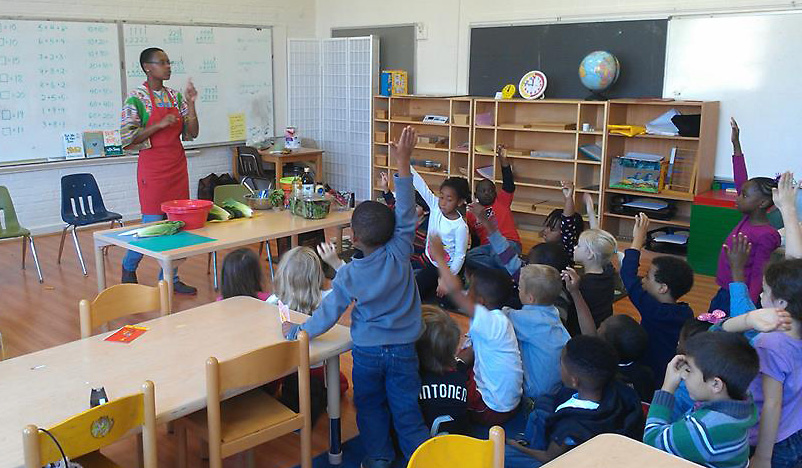I remember growing food in the third grade during garden club at Twin Oaks Community Garden in D.C. I grew onions, collard greens, and mustard greens. I’d bring my harvest home for my family to eat. My mother taught me how to wash them. My pencil legs towered over running water as we removed each stem from the leaves before dunking them into cold water. My greens tasted better than the canned Glory Greens my family bought, like the expensive loose leaf ones in the produce section of the grocery store.
 This post is part of the series
This post is part of the series
Science and Democracy: Community Voices
Image: Letizia Tasselli/Flickr
Anything from the produce section other than onions, potatoes, and cabbage was a treat. “Can we get them? Only $3.00 a pound for grapes,” I’d ask. “Put them back, ya gonna go through those too quick,” my mother would respond. For everyone to enjoy a weekly share of grapes, that would’ve cost her $15, enough money to purchase various flavors of Top Ramen noodles, Little Debbie snacks, and some generic brand cereal which usually had a larger box than its name brand counterpart. In the end it seemed like a fair compromise as we’d get a share of our daily requirement of fruits and vegetables through school lunch.
The evidence for healthier food
But after years of soggy vegetables and syrup-drenched fruit, I eventually grew frustrated with school lunch. In my senior year at Morgan State University, I joined the MSU Community Organic Vegetable Garden. Several students and I got tired of not having a variety of options in the dining hall most convenient to our classes. We saw no diverse fruit or salad options, just foods high in carbohydrates, fat, and sugar. Given my concern, I created my senior project around the issue, a qualitative research project on students’ knowledge of nutrition, eating habits, and dining service recommendations for a healthier campus. My results revealed that students would eat better if healthier options were provided as a part of the meal plan. I shared the results of my research with a few professors and went to meet with the Food Services Director, hoping for a change.
“We give students what they want and they’re not asking for fruits and vegetables”; “the contract is already done, we can’t change it right now,” they exclaimed. Just because someone doesn’t ask for something, doesn’t mean it’s not needed. How many servings of fruits and vegetables can you get out of fried chicken, French fries, and a soda? Or how many pre-diabetic and high blood pressure-prone college-educated adults is the higher education administration system creating when it only gives students what they want?
From observation to action
My experience with Food Services didn’t dissuade me. Instead, I took to heart the words of professor MK Asante, who wrote in his book, It’s Bigger than Hip Hop, “When you make an observation you have an obligation.”
In observing the unhealthy eating habits around me, I’ve been inspired to educate myself and my community. I started as an afterschool teacher at a local community center in Baltimore City and formed a garden club with Real Food Farm, an organization dedicated to improving food access and growing fresh food in Baltimore.
Later, I became an education assistant at Real Food Farm. In this role, I learned more about food system inequalities through recommended readings and documentaries and from facilitating food demonstrations and nutrition lessons. As often as I could, I would taste and cook with the produce on our farm before selling it on the mobile market, a repurposed and refrigerated Washington Post truck that delivers produce within several miles of east Baltimore City . I also helped determine the prices for foods uncommon to the community, like purple string beans, Romanesco broccoli, and Toscano Kale—all variations of commonly eaten foods with unfamiliar colors and textures. I’d explain to our customers the definitions of organic and local, along with the nutrition value of the produce they bought. Sometimes we would negotiate prices with them if they’d never tried it and offer free samples.
My journey through the food system has been split equally between learning and teaching. In the process of educating myself and others, I have witnessed changes in eating habits. I have received several inquiries from people wanting to know how to grow food themselves or improve their diet. It only takes one tomato grown the right way to make someone who hates tomatoes reconsider.

Myeasha Taylor facilitating a food demonstration and Part of the Plant lesson to children at Capitol Hill Montessori School during 2013 DC Healthy Schools Week.
Working together for food justice
I am no expert, just a curious and concerned citizen developing an idea and creating a just food system—where quality and affordable food are accessible for all people, regardless of their race and income.
The health food system is so vast, with many ways of contributing. Consumers can start by reading nutrition labels, pledging to eat something fresh each day, and sharing their dishes with the world via social media (i.e. food selfies; pictures and descriptions of their food).
Scientists, public health officials, dietitians, urban and regional planners, physicians, and nurses can continue or begin their journeys by looking at the role malnutrition plays in academic success, family medical histories, and overall health of communities lacking access to fresh food. This will not only identify disparities in food access, but will also challenge the structural systems that perpetuate those disparities; I believe that the results of such research will bring leaders to choose compassion over profit.
Based on what my experiences have taught me, the best ways to solve the problems of food insecurity are:
- Investigate: gather information about what’s happening in the community as far as where people buy food. It is best to find out if someone has already tried to address the issue in that area, and what technique they used.
- Create or use innovative solutions—i.e. establishing mobile farmers markets on wheels and farmers markets in dense or residential areas, promoting existing farmers markets and SNAP bonus buck incentives for purchasing produce, building school and/or community gardens/farms, and establishing healthy store initiatives.
- Identify and build relationships with key stakeholders from the community such as the local government, residents, schools, green spaces, civic organizations, higher learning institutions, churches, local businesses, and health clinics.
- Survey and receive consent from the community to implement most suitable strategy.
Our bodies desire to be nourished, to be fed food that gives us life, not food that takes up space.
In the words of Winston Churchill: “Healthy citizens are the greatest asset any country can have.”

